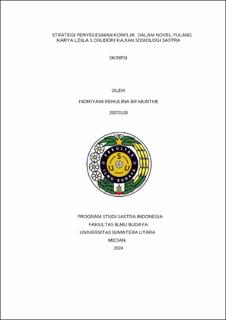Strategi Penyelesaian Konflik dalam Novel Pulang Karya Leila S Chudori Kajian Sosiologi Sastra
Conflict Resolution Strategies in the Novel Pulang By Leila S Chudori A Study of Literary Sociology

Date
2024Author
Munthe, Indriyani Rehulina Br
Advisor(s)
Dardanila
Marsella, Emma
Metadata
Show full item recordAbstract
This study specifically aims to describe the conflict resolution strategy in
Pulang by Leila S Chudori. This study uses a qualitative approach with a descriptive
method. This type of research uses a qualitative research method with a descriptive
method, where collecting and analyzing scientific data then describing the facts in
detail intends to find out the conflict resolution strategy in the novel Pulang by Leila
S Chudori. To deal with this situation, individuals often use various conflict
resolution strategies that reflect their personality, values, and social context. In the
novel Pulang by Leila S. Chudori, there is a description of how the characters deal
with various types of conflicts, both personal, social, and political. The research
studied is the conflict resolution strategy used by characters in literary works. This
approach provides an overview of the conflict resolution strategy used by characters
in the novel Pulang with Pruitt and Rubin's theory, namely: (a) Contending
(Contending) using authority or pressure to win a conflict or debate, resolving the
conflict according to their wishes without regard to the interests of the other party. (b)
Yielding (Giving in) Hananto's character lowers his aspirations or desires (to perhaps
go out of town or abroad) in order to maintain harmonious relations and avoid further
conflict with Surti., (c) Problem solving (Problem Solving) The parties who use this
strategy maintain their own aspirations, but simultaneously seek ways to reconcile
with the interests of the other party. Agreements in problem solving can be in the
form of compromises, (d) Withdrawing (Withdrawing) the withdrawing strategy is
implemented by leaving an increasingly heated debate, in the hope of avoiding
emotional harm and keeping the situation from getting worse., and (e) Inaction
(Silence) This strategy is temporary and can provide time for the parties involved to
reflect or observe the development of the situation before making further decisions.
Collections
- Undergraduate Theses [617]
